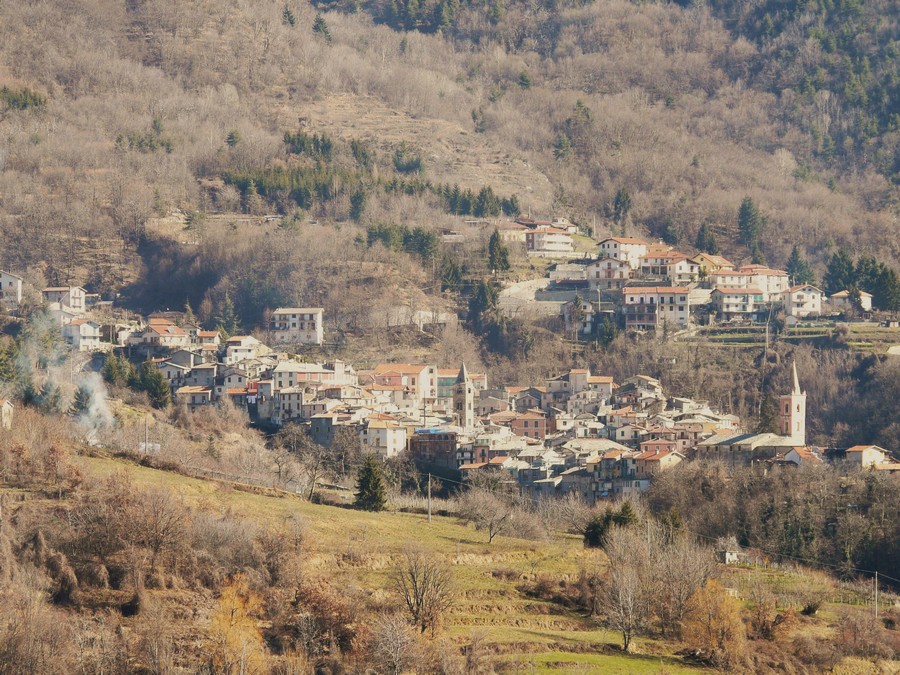Altitude: 721 m a.s.l.
Area: 41 sq km
Distance from Imperia: 32 km
Inhabitants: in 1881: 908 - in 2017: 218
Patron Saint Day: June 29th - Saints Peter and Paul
Information: Municipality phone 0183 327803
Cosio d'Arroscia was formerly the site of the Roman Villa located on the "Cuneus medianus".
The meaning of the toponym has also been interpreted as deriving from a settlement of a pre-Roman and Roman Ligurian population, the so-called Cosuanetes, whose name is also mentioned in the list of Alpine tribes reported on the monument erected by Augustus in La Turbie.
Many have been the struggles involving various local lords who continued to dispute the village, until in 1385 the "arbitration award" of the Genoese magistrate Antoniotto Adorno defined the dispute by entrusting the village as a fief to the Lengueglia family, who swore loyalty to Genoa, to which Cosio belonged ever since.
The village, only today lightly touched by the interest of snow lovers, keeps its medieval fabric intact.
Visit of the town
Park at the beginning of the village and go down the porphyry-cube ramp to the right that leads to the Municipal Loggia under which open on the right the simple portal of the old Town Hall and on the left the black stone portal of the Assunta Oratory with the massive monolithic architrave carved in a Gothic Trigram; the oratory is the seat of the male confraternity of Sant'Andrea and of the female one of Santa Caterina, among the very few still active in western Liguria.
From the small window on the façade you can observe the inside, furiously decorated with large festoons in white, red and blue cloth; the slender fourteenth-century bell tower, with two marble mullioned windows on each side and two low slits at the base, is better visible from the lower Piazzetta Scuole.
Back to the main road, continue to go down reaching the vast churchyard of the church of San Pietro rebuilt in the seventeenth century on the pre-existing fifteenth-century building of which the column chunks remain on both sides of the entrance and, curiously, inside, the two capitals, laid on the ground one on the right and one on the left of the high altar; in the marble jambs at the entrance are engraved the dates 1618-1636 of the beginning and the end of the reconstruction.
Inside, decorated with red, white and gold canvas festoons, to the left of the main altar is preserved the sixteenth-century canvas "The Mysteries of the Rosary" among anonymous seventeenth-century canvases, with a frame that circularly follows the small paintings surrounding the image of the Virgin; in the nearby chapel on the left there is another much simpler painting on the same theme, with the fifteen scenes grouped in three bands at the base of the work, without a frame.
Leaving the church, go around the left side passing under the loggia beyond the bell tower and return to the churchyard, from which you can go up again taking then the right along Via Palestro and venturing into the heart of the medieval village with the alleys almost entirely covered by archivolts.
After passing the plaque affixed at the center of the vault and the small semicircular wash-basin, you will arrive to the clearing from which, if you venture to the right under the vault of Via Contraria, you’ll immediately find on the right an overdoor carved in a Trigram; if instead you climb the ramp to the left, you’ll reach the small square under whose vault to the left opens a black stone portal of 1591 with a Trigram-carved lintel in a tondo and jambs decorated with floral motifs with a rosette in the center, a decoration that is repeated identical on the two plaques affixed on the sides of the adjacent staircase.
Crossing the small square, pass under the vault on the right and immediately after take to the left the Vico Gandolfi staircase, passing -along the stairway of the narrow passage on the right- a house with a window with tuff jambs.
After the smooth stone monolithic overdoor on the left, go under the vault of Via Mazzini, reaching the portal with jambs decorated with floral motifs at number 36 on whose lintel the Christian protection of the central Trigram is complemented by the pagan protection of the two guardian wizards on the sides.
A little further on there is an archaic fourteenth-century house on the right with a smooth stone arched portal surmounted by a mullioned window with a stone column and a massive monolithic window sill; it’s a pity that on the upper floor the improper addition of a terrace has disfigured the whole facade.
Pass under the vault and turn right; once in Piazzetta Vittorio Emanuele turn left and go straight on passing along the side of the oratory, from which you can go to the right to get the car.
A reflection before leaving the village: of particular interest is the Museo delle Erbe (Museum of Herbs) - a festival is dedicated to their knowledge.
The modest little town of Cosio has an unexpected importance for contemporary culture and art, being the cradle of the Situationist movement whose manifesto was written there in 1957.
Crossing the village, continuing along the Provincial Road, after three and a half kilometers of mountain excursion you’ll get to the State Road 28, from which you can descend to the right through the hamlets of Case Rosse and then Pornassio and Pieve di Teco continuing to descend to the sea on the road already traveled on the way up.
If, on the other hand, you turn left, you can climb the 941 meters of altitude of the Nava hill from which you can descend to Nava to end up in Ponte di Nava, which marks the border between Liguria and Piedmont; from there it’s possible to take a whole number of beautiful naturalistic mountain excursions.


